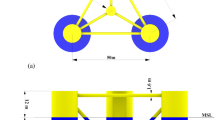Abstract
A design of offshore floating structure is mainly based on the extreme response analysis due to the forces experienced. The extreme response can induce the negative air gap response and potential impact to the deck bottom of floating structure. It is important to predict the slamming load in order to check the strength of local structures which withstand the wave slamming. In recent years, studies of the effects of wind load on air gap response and slamming load are ignored. When the platform suffers the extreme wave, the wind is also harsh. Moreover, the wind load can affect the motion response of the platform. The wind load cannot be simulated easily by model test in towing tank whereas it can be simulated accurately in wind tunnel test. Though the model test results are not accurate enough for air gap and slamming load evaluation due to the loss of wind effect, they can be used as a good basis for tuning the radiation damping and viscous drag in numerical simulation. This paper aims at presenting the sensitivity analysis results of wave slamming load with respect to the wind load for the design of semi-submersible platform. As an example of semi-submersible drilling platform design, the wind tunnel test has been carried out, and the sea-keeping model test is also performed in towing tank, while the wind load effect is ignored. According to the model test results, a numerical model is tuned and validated by ANSYS AQWA. Sensitivity analysis studies of the relative velocity between water particle and platform surface and the wave slamming load with respect to the wind load are performed in time domain by the tuned numerical model. Five simulation cases about the presented platform are simulated based on the results of wind tunnel tests and sea-keeping tests. The sensitivity analysis results are valuable for the floating platform design.
Similar content being viewed by others
References
DNV. Column-stabilised units (DNV-RP-C103) [M]. Veritasveien, Norway: Det Norske Verital AS, 2012.
Kazemi S, Incecik A. Numerical prediction of air gap response of floating offshore structures using direct boundary element method [C]// Proceedings of the 24th International Conference on Offshore Mechanics and Arctic Engineering. Halkidiki, Greece: OMAE, 2005: 67399.
Kazemi S, Incecik A. Theoretical and experimental analysis of air gap response and wave-on-deck impact of floating offshore structures [C]// Proceedings of the 26th International Conference on Offshore Mechanics and Arctic Engineering. San Diego, California USA: OMAE, 2007: 29288.
Rudman M, Cleary P W. Rogue wave impact on a tension leg platform: The effect of wave incidence angle and mooring line tension [J]. Ocean Engineering, 2013, 61: 123–138.
Sekhar G R, Nallayarasu S. Wave slam/slap loads on structural members in the air-gap [C]// Proceedings of the 30th International Conference on Offshore Mechanics and Arctic Engineering. Rotterdam, the Netherlands: OMAE, 2011: 49507.
Liang X F, Yang J M, Xiao L F, et al. Numerical study of air gap response and wave impact load on a moored semi-submersible platform in predetermined irregular wave train [C]// Proceedings of the ASME 2010 29th International Conference on Ocean, Offshore and Arctic Engineering. Shanghai, China: OMAE, 2010: 20230.
Shan T B, Yang J M, Li X, et al. Experimental investigation on wave run-up characteristics along columns and air gap response of semi-submersible platform [J]. Journal of Hydrodynamics, 2011, 23(5): 625–636.
Simos A N, Sparano J V, Aranha J A P, et al. 2nd order hydrodynamic effects on resonant heave, pitch and roll motions of a large-volume semi-submersible platform [C]// Proceeding of the 27th International Conference on Offshore Mechanics and Artic Engineering. Estoril, Portugal: OMAE, 2008: 57430.
Sweetman B, Winterstein S R, Meling T S, et al. Air gap prediction: Use of second-order diffraction and multi-column Models [C]// Proceedings of the Fourteenth International Offshore and Polar Engineering Conference. Stavanger, Norway: International Society of Offshore and Polar Engineers, 2001: 390–397.
DNV. Structural design of column stabilised units (LRFD method) (DNV-OS-C103) [M]. Veritasveien, Norway: Det Norske Verital AS, 2012.
DNV. Environmental conditions and environmental loads (DNV-RP-C205) [M]. Veritasveien, Norway: Det Norske Verital AS, 2010.
Bitner-Gregersen E M. Joint probabilistic description for combined seas [C]// Proceedings of 24th International Conference on Offshore Mechanics and Arctic Engineering. Halkidiki, Greece: OMAE, 2005: 67382.
Winterstein S, Ude T C, Comell C A, et al. Environmental parameters for extreme response inverse FORM with omission sensitivity [C]// Proceedings of the 6th International Conference on Structural Safety and Reliability. Innsbruck, Austria: A A Balkema, 1992: 42827.
Author information
Authors and Affiliations
Corresponding author
Additional information
Foundation item: the National Natural Science Foundation of China (No. 11072149)
Rights and permissions
About this article
Cite this article
Huo, Fl., Zhang, Hx., Suo, J. et al. Sensitivity analysis of wave slamming load with respect to wind load for semi-submersible platform design. J. Shanghai Jiaotong Univ. (Sci.) 20, 385–394 (2015). https://doi.org/10.1007/s12204-015-1619-6
Received:
Published:
Issue Date:
DOI: https://doi.org/10.1007/s12204-015-1619-6



